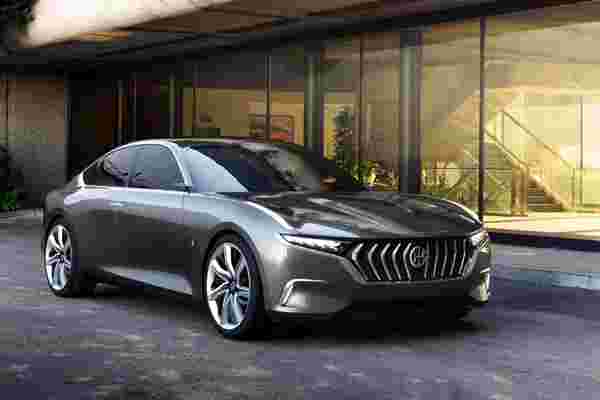With the threat of environmental catastrophe looming over our heads, it’s not only on individuals to make smart choices regarding sustainability in our daily lives, but also—and in fact more importantly—on the major corporations across all industries. The consumer goods industry, in particular, is a double-edged sword. The general public condemns businesses for their wasteful practices yet lines up to purchase the newest smartphone or limited-edition fashion collaboration the second it hits the market. As long as the demand for products exists, they’ll be produced. What matters, then, is how companies are working to tackle the challenges of sustainability: We’ve spoken to leaders across five major consumer goods industries to learn about what’s going on behind the scenes.
Cars

Italian car designer Pininfarina, alongside Hybrid Kinetic Group, debuted the H600 electric luxury sedan in 2017.
One of the most obvious forms of sustainability-focused solutions in the automotive industry is the vast range of electric cars on the market. But for every customer who’s excited about the move away from fuel, there’s another who’s hesitant or even resistant to change. “When luxury vehicle consumers are shopping for electric vehicles, they are not willing to make compromises compared to their present luxury vehicle,” says Audi ONE director Cody Thacker. Audi’s first mass-produced electric vehicle was the e-tron, an SUV that first delivered in May 2019, which the German manufacturer designed to offer the same level of performance and luxury an Audi customer would expect of a traditional SUV.
Enticing customers, however, must go far beyond the car. “With an electric vehicle, an ecosystem to provide charging is essential,” says Thacker. “We’ve partnered with Amazon Home Services to prepare customers for home charging, and partnered with Electrify America to provide high-speed charging on highway journeys and Arcadia to provide access to renewable energy.” Changing the infrastructure to facilitate electric vehicles is crucial to their widespread success. “We are excited about the opportunity to create zero-emission vehicles, but it is our goal that sustainable transportation goes much further than the personal car,” says Paolo Pininfarina, chairman of Pininfarina, an Italian car design firm who has collaborated on environmental issues with such brands as Ferrari and Jaguar. “We’ve become more engaged in the design of smart cities, investigating infrastructures, mobility networks, energy grids, and recharging systems. Sustainability is about how you live, not just how you move.”
Perhaps even more important than the consumer-facing side of the industry is what goes on on the manufacturing side. Production accounts for approximately 50 percent of Audi’s carbon impact, so the company has set a goal to make its factories carbon-neutral by 2025. Other carmakers have invested in building their facilities from the ground up to be carbon-neutral—take, for instance, Tesla, which is constructing Gigafactory 1 in Sparks, Nevada, to be one of the greenest production centers in the world.
But there are manufacturing components that are beyond the direct control of the automakers, which will require a different set of solutions. Take the supply chain, for instance. “The high-voltage battery powering electric vehicles is under the highest scrutiny,” says Thacker. “The responsible, ethical mining of battery component materials and identification of viable second life and recycling options for used batteries is garnering a lot of internal focus at Audi.” There’s no clear-cut solution, but automakers must rise to the challenge.
Fashion

Cult favorite shoe brand Allbirds uses sustainable materials in its products, from merino wool to eucalyptus tree fiber to sugar cane.
One of the largest sustainability initiatives in the fashion industry is to reduce overconsumption and waste. “We make, take, and waste at an alarmingly fast pace,” says Nicole Heim, founder of New York–based label Cienne, which strives to produce ethical and sustainable clothing. In the fashion industry, mass production of goods creates plenty of excess, and in many cases, unsold goods are burned by both luxury and fast-fashion brands. On the consumer front, customers line up to buy pieces from new collections and send their old items out the door, often into the garbage. Even donating clothes could be an issue— according to a report by Fast Company , Goodwill spends $7 million on dumping clothes into landfills in California.
To help combat overconsumption, Cienne manufactures small-batch collections rather than mass-produced ones—it’s a method that costs more upfront, but reduces both environmental and financial waste. Heim is also looking into made-to-order options to scale back production even further. “I believe both consumers and brands need to shift their mindsets and ways of consumption in order to make meaningful change happen,” she says.

Womenswear label Cienne creates small-batch clothing lines to reduce fashion waste.
While the footwear industry also faces similar challenges of waste, it also struggles with outdated manufacturing practices and materials. “The majority of the materials used in footwear are synthetic materials, which are plastics derived from fossil fuels,” says Hana Kajimura, sustainability lead at New Zealand shoe brand Allbirds. “The reliance on cheap synthetics comes down to the tight margins footwear brands face when they sell through wholesale channels. The push to drive down manufacturing and raw material costs doesn’t encourage investment in more environmentally friendly options.”
Allbirds does what any company can—it levied a carbon tax upon itself to promote carbon neutrality, and it uses recycled materials in its packaging, which itself is recyclable. But innovation is key to Allbirds’ long-term sustainability. “In 2018 we launched a proprietary sole material, SweetFoam, made with the world’s first green ethylene-vinyl acetate (EVA) that is derived from renewable sugarcane and carbon negative in its raw form,” says Kajimura. “We then open-sourced this green EVA technology so that any other company could switch from the standard petroleum-based EVA to a lower impact option.
Furniture
Detroit-based furniture company Floyd designs easy-to-move furniture with changeable parts.
As with all consumer goods industries, waste is major concern in the furniture sector. “The Environmental Protection Agency estimates 9.8 million tons of furniture waste is thrown into landfills in the U.S. every year,” says Kyle Hoff, founder and CEO of Detroit-based furniture company Floyd. “We started Floyd because my co-founder, Alex, and I were frustrated with the disposability of furniture.”
Every time you move houses or apartments, undertake a renovation, or simply redecorate, it’s easy to find yourself tossing unwanted furniture out on the curb. “Our mission is to change and improve the way people consume, keep, and enjoy their furniture by being obsessive about thoughtful design and modularity that can adapt to your needs over time,” says Hoff. Floyd furniture, for instance, is delivered to customers in a flat pack and is easy to assemble and disassemble—it’s designed to move with you. It’s also made from serviceable parts. “Welds break and cushions sometimes tear, but the product shouldn’t be thrown away because of this,” says Hoff. “We design all of our products to be a kit of parts that can be replaced, so you don’t end up throwing out the whole thing. It’s something that we learned from Charles and Ray Eames.”
While new companies like Floyd, which was launched in 2014, are able to disrupt outdated furniture practices to confront challenges in sustainability, there’s more of an uphill battle for established brands like IKEA, which has long been known for its affordable (and therefore easily disposable) furniture. But the Swedish giant is working hard to address concerns, setting a goal to become a circular company by only using renewable or recycled materials in its products by 2030. The journey has already begun—IKEA has removed single-use plastics as of January 1, and it expects to replace virgin polyester textiles with recycled ones by the end of this year.
By 2030, Swedish furniture giant IKEA hopes to become a circular business, reducing wasteful practices by using only renewable or recycled parts in its products.
“The circular economy moves away from the traditional ‘take-make-dispose’ economic model to one that is regenerative by design,” says Lena Pripp Kovac, chief sustainability officer of the Inter IKEA Group. “The goal is to retain as much value as possible from resources, products, parts and materials to create a system that allows for longer life, optimal reuse, refurbishment, re-manufacturing, and recycling.”
It would seem that IKEA is actually taking a page out of Floyd’s book. “For IKEA it means seeing our products as material banks for the future, and taking every opportunity to extend their lifespan through care and repair, and enabling different models for passing on of products that are still in good shape,” says Pripp Kovac. “For example, already today we are exploring leasing and buy-back programs. Through refurbishment and remanufacturing, we are able to restore products to like-new condition through small repairs, and when no longer possible to fix, we are aiming to utilize all usable parts in the production of new products.”
Rather than wait for companies to make these changes slowly, Hoff urges consumers to insist on them now. “Don’t underestimate your power as a customer to create a demand for change,” says Hoff. “If consumers demand better, longer-lasting materials and more sustainable practices from the businesses they love, we can put an end to the cheaply-made synthetics that almost always wind up in a landfill.”
Electronics
Apple has developed a robot named Daisy to disassemble iPhones to harvest and recycle their inner parts.
When it comes to sustainability in consumer electronics, there are two major players: e-waste and mining for precious metals, which are actually very closely linked. Given that electronics are an everyday part of life for both consumers and corporations, there’s very much a cycle of buy product, use product, toss product, and repeat. Electronics manufacturers have already caught onto this. Most major companies, from Microsoft to Samsung, have well-established trade-in programs that allow parts from older machines to be recycled into refurbished ones, preventing parts—especially those with potentially harmful materials—from ending up in landfills.
There is, however, a limit to what can be recycled from an electronic device, so there’s still a demand for the mining of earth elements like aluminum, gold, and cobalt, all of which are necessary components of electronics. Apple is working to find ways to recycle that material. It’s developed a robot named Daisy that’s capable of disassembling even the tiniest components of iPhones, allowing material that was formally impossible to recycle to be harvested and reused in other products—it’s part of the company’s goal to become a circular business, which it announced in 2017.
But for now, as with car manufacturing, electronics companies don’t have control over each company in its supply chain, and that’s where excessive carbon emissions (and practices like mining for rare materials) still run rampant. Though Apple currently runs all of its facilities from data centers to retail stores with renewable energy, it’s developed a program to push for sustainable practices in its suppliers. As of February 2020, the company reports that 44 of its manufacturers have committed to using clean energy sources. “By running all of our operations with 100 percent renewable energy and asking that our suppliers do the same, we are creating new pathways that others can follow to address the impacts of climate change,” says Lisa Jackson, vice president of environment, policy, and social initiatives at Apple.
Packaging
Canadian company Good Natured develops plant-based plastics designed to revolutionize packaging.
As consumer goods companies push forward toward more sustainable practices, one major focus is on packaging, an area that is, by nature, incredibly wasteful. Plastics, in particular, are a major concern, as evidenced by the scaling back of single-use plastics around the world. While using more sustainable materials like cardboard can be one solution, it’s not practical for all packaging. Enter plant-based plastics. “A plant-based plastic is made, all or in part, from renewable resources instead of petroleum,” says Paul Antoniadis, CEO of Good Natured, a plant-based packaging company based in Vancouver. “By relying on renewable raw materials that can rapidly replenish themselves, we’re reducing the burden on limited fossil fuels to produce everyday products, like food packaging and household items.”
Plant-based plastics, also known as bioplastics, are poised to revolutionize the packaging industry, as they are not only more efficient to produce, reducing CO2 emissions by up to 50% as compared to petroleum-based plastic, but also easier to recycle. “Compost facilities are eager to collect food scraps but are not equipped to separate food scraps from a variety of used containers,” says Antoniadis. “Various industry associations, including the Compost Manufacturing Alliance, continue to develop programs to ensure the food scraps and their associated packaging can all go into a compost facility as a single stream and be turned back into soil to grow more plants.”
The ultimate resource for design industry professionals, brought to you by the editors of Architectural Digest
The biggest hurdle facing plant-based plastics, however, is educating companies on their existence, their solid performance as compared to petroleum-based plastics, and their financial feasibility to be introduced into the supply chain. “Although the technology has been around for many years, it’s only in the last five to ten years that we’ve seen more attention on compostable, renewable plant-based plastics as an alternative to petroleum-based products, especially for food packaging,” says Antoniadis. “Most plant-based companies are still relatively new, and so getting the message out about the benefits of using renewables instead of petroleum to make everyday products and packaging can be quite challenging.”
